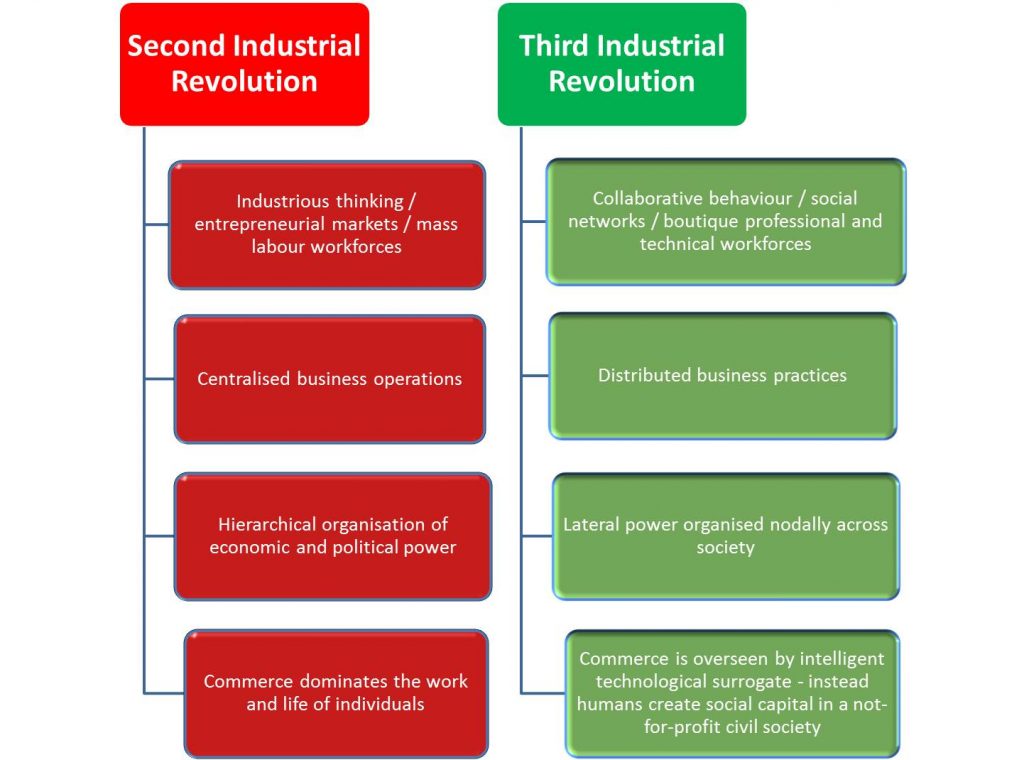INSIGHTS
A new narrative for the post-carbon era
We don’t think today’s industrial framework can continue as before. But what comes next? Some are exploring new forms of capitalism. Jyoti Banerjee explores the post-carbon framework laid out in Jeremy Rifkin’s Third Industrial Revolution.
Basic proposition
Our industrial civilisation is at a crossroads. Oil and other fossil fuel energies that make up our industrial way of life are sunsetting, and the technologies made from and propelled by these energies are antiquated. The entire industrial infrastructure built on the back of fossil fuels is aging and in disrepair. The result is that unemployment is rising to dangerous levels all over the world.
Governments, businesses and consumers are awash in debt, and living standards are plummeting. A record one billion humans face hunger and starvation. Worse, climate change from fossil fuel-based industrial activity looms on the horizon – cataclysmic change in the temperature and chemistry of the planet.
This is the setting for Jeremy Rikfin’s key proposition in his book, Third Industrial Revolution: How Lateral Power is Transforming Energy, the Economy and the World – “Great economic revolutions occur when new communications technologies converge with new energy systems.”
How can we understand these elements of a revolution? Energy systems make possible the creation of more interdependent economic activity and expanded economic exchange, and facilitate more dense and inclusive social relationships. On the other hand, a communications revolution provides the means to organise the manage the new temporal and spatial dynamics that arise from new energy systems.
Rifkin’s vision of a Third Industrial Revolution is based on the meeting of two key revolution components: Internet technologies plus renewables. But what would this look like? Hundreds of millions of people will produce their own renewable energy in homes, offices and factories and share it with each other in an “energy internet.”
If Rifkin is right, the implication would be a fundamental re-ordering of human relationships: how we conduct business, govern society, educate our children and engage in civic life.
How will the Third Industrial Revolution differ from its predecessors? The First Industrial Revolution was built around the marriage of steam power with the communications prowess of the printing machine. The Second Industrial Revolution brought together the energy from fossil fuels with electrical communications, such as radio and TV, plus the personal communications of the telephone.
But would a move to renewables and collaborative communications technologies really result in a different world? Check out this table below to get a sense of what the changes could be.

New narrative
What Rifkin’s model does is enable the creation of a narrative for what the next industrial revolution can look like. This is important because there is deep dis-satisfaction with the status quo but very little insight as to what the next generation of human relationships (and, therefore, business relationships) can look like. What Rifkin is saying is that the new forms of communication – already flourishing in the form of mobile and social media – become the medium for organising and managing the more complex civilisations made possible by the new forms of energy. The infrastructure that emerges annihilates time and shrinks space, connecting people and markets in more diverse economic relations.
Infrastructure used to be thought of as a static set of building blocks that serve as a kind of fixed foundation for economic activity. Instead, in this new model, infrastructure should be thought of as an organic relationship between communications technologies and energy sources that, together, create a living economy. Rifkin renders it thus: “Communications technology would be the nervous system that oversees, co-ordinates, and manages the economic organism, while energy is the blood that circulates in the body politic, providing the nourishment needed to convert nature’s endowment into goods and services to keep the economy alive and growing. in effect, infrastructure is a living system that brings increasing numbers of people together in more complex economic and social relationships.”
The role of communications
The communications revolution of the 90s and later differs from the previous era of communications revolutions in that telephone. radio and TV were centralised forms of communications built around centralised fossil energies. Today’s new social and mobile communications structures are ideally suited to distributed, democratic energy. The silicon revolution has breathed new life into the old industrial model, but it can never reach its full potential without an accompanying energy revolution.
The implications for business are huge.
In the post-carbon era, hundreds of millions of human beings will be generating their own green energy in their homes, offices and factories and sharing it with one another across intelligent distributed electricity networks – an intergrid – just like people now create their own information and share it across the Internet.
Our businesses are not built this way. Typically, they are organisms constructed around centralised power. Yet, we have seen numerous examples of how distributed power (what Rifkin calls lateral power) can overwhelm centralised power. Look at how music sharing is devastating the music industry, or how Wikipedia’s crowd wisdom dismantled the ivory tower knowledge of Encyclopedia Britannica.
We can already see that the conventional top-down organisation of society that characterised much of the social, economic and political life of the fossil fuel-based industrial revolutions is giving way to distributed and collaborative relationships in the emerging green industrial era. But this is not enough. For the Third Industrial Revolution to take hold, Rifkin recognises that a number of other shifts need to take place simultaneously:
- Shifting to renewable energy
- Transforming the building stock of every continent into micro-power plants to collect renewable energies on site
- Deploying hydrogen and other storage technologies in every building and throughout the infrastructure to share intermittent energies
- Using internet technology to transform the power grid of every continent into an energy-sharing intergrid that acts just like the internet
- Transitioning the transport fleet to electric plug-in and fuel cell vehicles that can buy and sell electricity on a smart, continental, interactive power grid.
The Third Industrial Revolution has not taken place as yet. Some of its elements, such as collaborative democratic communications, are already in place, Others, such as levelling the energy playing ground so that renewables get the impetus they need, would need a considerable degree of political design and technological innovation. But what is clear is that a narrative exists that can help organisations decipher the failing structures of today, and which enables them to prepare for a different world order.
Just re-inventing capitalism is too limited a view to deliver this.
MORE FROM INSIGHTS
Assessing the impacts and outcomes of integrated reporting
Fronesys founders played influential roles in the development of the integrated reporting movement, a corporate reporting mechanism that now has around two thousand listed companies as its adopters, and which is now part of the mainstream of corporate reporting. So, perhaps, now is as good a time as any for Jyoti Banerjee to look back and assess the outcomes and impacts, as well as the what-might-have-beens, of this new form of corporate reporting.
Integrated thinking is focus of chapter in new Oxford handbook
Oxford University Press has just released a new chapter from the forthcoming Oxford Handbook of Food, Water and Society: Integrating Multi-Capital Thinking in Business Decisions. The new chapter, contributed by Fronesys partner Jyoti Banerjee, explores how we need to change our understanding of value. Here is Jyoti’s account of what you can expect in this new publication.
A Shift in Perspective – How Universities Create Value
Jyoti Banerjee, partner at Fronesys, highlights that by adopting the principles of integrated thinking and reporting, universities can move away from a focus on reporting short term financial metrics to a multi-stakeholder approach which offers compelling narratives about their value.
SOCIAL FEED
[juicer name=”fronesys” per=’9′ pages=’1′]




0 Comments